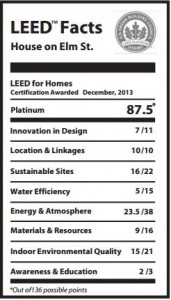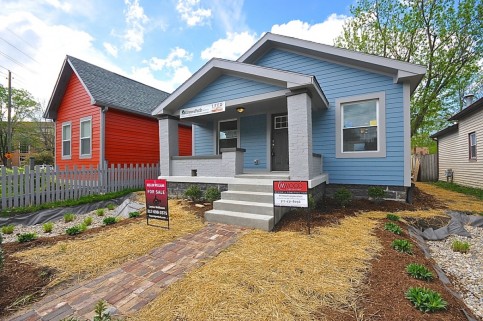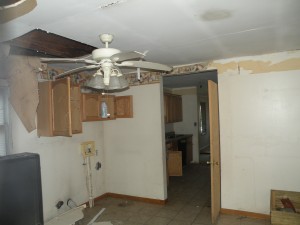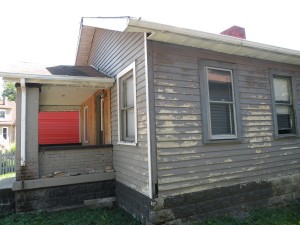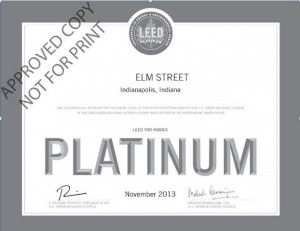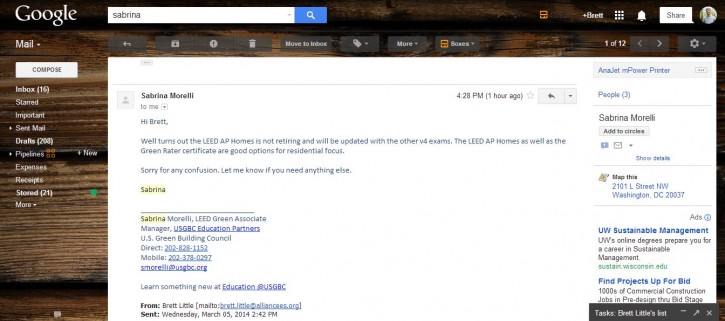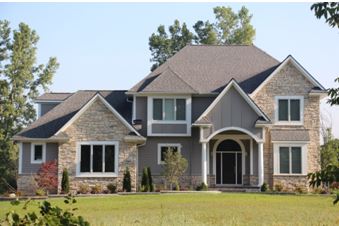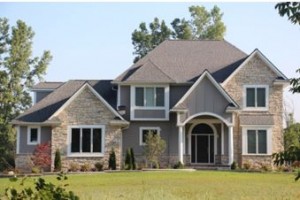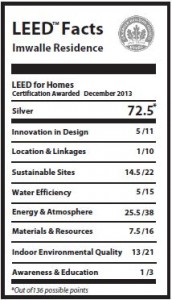Written by Chris Long
The concept of conservation in the bathroom used to be limited to shutting off the water while brushing your teeth and taking shorter showers. And while those lessons still apply (the former saving as much as 3,000 gallons of water annually, according to the Environmental Protection Agency), our capability to be kinder to the Earth in the restroom now far surpasses being smart about turning the tap. The market is awash in energy-efficient fixtures and eco-friendly finishes that are also stylish selections for a bathroom-remodeling project. Below, I’ll shower you with some clever ideas for going green on everything from showerheads to vanity cabinets.
Eco-friendly Fixtures
1. Sink & Bathtub Raucets: Whether you’re retrofitting an existing basin or outfitting a new sink, look for faucets and accessories (such as an aerator) with the WaterSense label. This Environmental Protection Agency partner program certifies high-performing, water-efficient products — meaning you won’t sacrifice pressure for preservation — that use no more than one-and-a-half gallons per minute, a 30 percent reduction in flow from the standard, claims the WaterSense website. And incorporating WaterSense faucets also allows you to enjoy a trickle-down effect in savings; by utilizing less water (the program says as much as 500 gallons annually), a household also decreases demand on water heaters, in turn reducing energy consumption. Plus, many state governments offer rebates for the purchase of WaterSense and other low-flow items; check with your state’s environmental agency for information.
2. Showerheads: Since the EPA asserts that showering accounts for some 17 percent of a household’s water usage, sophisticated shower fixtures present a simple solution to water conservation. While standard showerheads pour out roughly two-and-a-half gallons of water each minute, the EPA only awards its WaterSense label to those that have been proven to spout no more than two gallons per minute. And just as when buying credited faucets, consumers needn’t worry that performance in WaterSense showerheads will be watered down. The EPA teamed with various stakeholders to test the products’ spray intensity and ensure satisfactory results.
3. Toilets: The EPA estimates that the average residence flushes close to 30 percent of its water down the toilet, with outdated lavatories using upwards of six gallons of water per flush. But dual-flush options allow users to select full or half flushes depending on the need (i.e., number one or number two). Newer models require 1.28 gallons per flush or less, a surefire way to keep your water usage out of the commode.
4. Lighting: Going green in the bathroom is a good thing; looking green in the bathroom is not. So be sure that the lights you select for your bathroom accurately reflect the colors of clothing, skin, and cosmetics. Seek out Energy Star-qualified LED fixtures, which boast precise color representation, steady light streams, and excellent brightness. (Beware of LEDs that are not Energy Star qualified, as these may fail to deliver on quality and efficiency.)
5. Ventilation: Moist air can lead to mold and mildew troubles that will leave your bathroom feeling less than clean, so be sure to protect your indoor air quality by properly venting that saturated space—this means ensuring the vent reaches the outside of the home, as opposed to just the attic, where moisture can also become trapped and lead to a mold problem. (In fact, the National Kitchen & Bath Association includes among its good practices guidelines specific direction to “plan a mechanical exhaust system, vented to the outside.”) Energy Star-qualified bathroom exhaust fans, such as those manufactured by Panasonic and Delta Breez, boast quiet and energy-efficient DC motors for high performance and long life. Some models, including Panasonic’s WhisperGreen LED and the Delta Breez VFB080D4LED1, also include an LED light feature for an eco-smart combo.
Earth-fresh Finishes
1. Cabinets: When selecting a vanity, look for wood certified by the Forest Stewardship Council, which highlights lumber harvested from a sustainably managed forest. Steer clear of particleboard and medium-density fiberboard, which the EPA states can pollute indoor air with formaldehyde emissions. And remember that reusing an existing piece of furniture to create a vanity base is a creative way to go green.
2. Countertops: Manmade counter creations have come a long way in terms of aesthetics, so think beyond natural stone. The company CaesarStone recycles manufacturing waste in a scratch, stain and mildew-resistant quartz that has been featured in LEED-certified showcase projects. Companies like Vetrazzo transform recycled glass from residential recycling programs, demolition sites, old windshields, and the like into stunning glass-chip countertops in a rainbow of colors.
3. Flooring: Both durable and easy-to-clean, ceramic tiles (especially those with a high recycled content) and natural linoleum flooring are ideal, eco-friendly choices for a bathroom floor. Manufacturers like Terra Green Ceramics and Armstrong offer a variety of green options.
4. Curtains & Towels: While most of us associate bathrooms with hard surfaces, don’t forget that they have a softer side in the form of window treatments, shower curtains, and towels. Be sure to select organic fabrics, which are produced with fewer pesticides and toxins than their standard counterparts, for these design accents. Consider swapping out your vinyl shower curtain, which can release airborne toxins, for one made of sturdy cotton (try Lifekind’s Certified Organic Cotton Shower Curtain, Are Naturals’ Seersucker Organic Cotton Shower Curtain, or the organic cotton prints from Pottery Barn).
While many of the eco-friendly choices on the market can be costlier up front, remember that the savings you will encounter on water and energy bills more than makes up the difference (often in a matter of months). To take time to set your budget, incorporate everything from labor costs and materials to fixtures and finishes to sales tax before diving into a remodeling project. (I also recommend adding on 10 percent for unexpected costs, extras, and upgrades.) And as with any bathroom renovation, be sure to budget your time wisely as well. A ceiling-to-floor overhaul could leave your family without those facilities for several months, so think through alternative places to shower and use the restroom.
Feel free to share the ways you’ve gone green on your bathroom scene!
Chris Long has been a Home Depot store associate in the Chicago suburbs since 2000 and also writes for the Home Depot website. Chris’ DIY interests include providing tips on bathroom renovations for vanities, sinks, showers and tubs. To view Home Depot’s bath vanities page, click here.
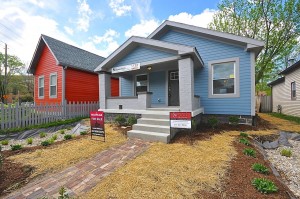 This home located on Elm St. in Indianapolis, IN was an abandoned space, built in 1910, that was bid on for redevelopment through the Southeast Neighborhood Development (SEND) organization’s Transfer and Transform program, which seeks to reinvigorate the community
This home located on Elm St. in Indianapolis, IN was an abandoned space, built in 1910, that was bid on for redevelopment through the Southeast Neighborhood Development (SEND) organization’s Transfer and Transform program, which seeks to reinvigorate the community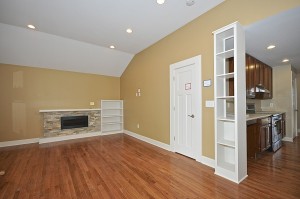 The small 960 sq ft. 2 bedroom 1 bath home is located in an area with outstanding access to community resources such as public transportation. This well sealed home uses energy efficient appliances and is expected to save 47% on energy bills. Insulated piping adds to the efficiency of this home.
The small 960 sq ft. 2 bedroom 1 bath home is located in an area with outstanding access to community resources such as public transportation. This well sealed home uses energy efficient appliances and is expected to save 47% on energy bills. Insulated piping adds to the efficiency of this home. 